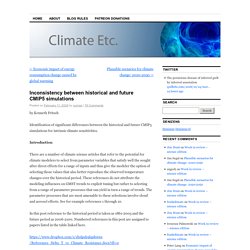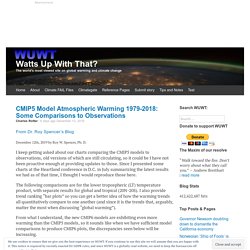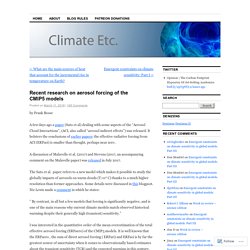

Analyzing Observed vs CMIP5 Model Simulations of Global Temperature. Paper Reviewed Chylek, P., Folland, C., Klett, J.D. and Dubey, M.K. 2020.

CMIP5 climate models overestimate cooling by volcanic aerosols. Geophysical Research Letters 47, e2020GL087047. Chylek et al. (2020) introduce their work by noting climate model simulations of global mean surface temperature diverge from the observational record around the turn of the 21st century, with "the model warming being somewhat too high. " Two possible explanations for this discrepancy that they go on to investigate include (1) a failure of the models to properly account for aerosol forcings from volcanic eruptions and (2) a general underestimation of solar forcing. In describing their findings, the authors report that "climate models overestimate the cooling effect of volcanic activity and underestimate the effect of the variability of solar radiation. "
Inconsistency between historical and future CMIP5 simulations. By Kenneth Fritsch Identification of significant differences between the historical and future CMIP5 simulations for intrinsic climate sensitivities.

Introduction There are a number of climate science articles that refer to the potential for climate modelers to select from parameter variables that satisfy well the sought after direct effects for a range of inputs and thus give the modeler the option of selecting those values that also better reproduce the observed temperature changes over the historical period. These references do not attribute the modeling influences on GMST trends to explicit tuning but rather to selecting from a range of parameter processes that can yield in turn a range of trends. The parameter processes that are most amenable to these selections involve cloud and aerosol effects. In this post reference to the historical period is taken as 1861-2005 and the future period as 2006-2100. CMIP5 Model Atmospheric Warming 1979-2018: Some Comparisons to Observations. From Dr.

Roy Spencer’s Blog December 12th, 2019 by Roy W. Northern Hemisphere snow cover trends (1967-2018): A comparison between climate models and observations. According to the climate models, snow cover should have steadily decreased for all four seasons.

However, the observations show that only spring and summer demonstrates a long-term decrease. Ronan Connolly, Michael Connolly, Willie Soon, David R. Legates, Rodolfo Gustavo Cionco , and V. M. Velasco Herrera Abstract: Observed changes in Northern Hemisphere snow cover from satellite records were compared to those predicted by all available CMIP5 climate models over the duration of the satellite records, i.e., 1967-2018. 1. Snow cover represents one of the main components of the cryosphere, along with sea ice [1], permafrost [2] and the various ice sheets and glaciers [3,4]. Temporal changes in snow cover are an important part of global climate change for at least two reasons. Weekly satellite-derived observations for the Northern Hemisphere are available from November 1966 to the present (historical snow cover data provide less spatial and temporal coverage for the Southern Hemisphere).
Skill of seasonal Arctic sea ice extent predictions using the North American multi-model ensemble: Journal of Climate: Early Online Release. Problems Modelling Antarctic Ice Sheet and Southern Ocean Temps. Paper Reviewed Schneider, D.P. and Reusch, D.B. 2016.

Antarctic and Southern Ocean Surface Temperatures in CMIP5 Models in the Context of the Surface Energy Budget. Journal of Climate 29: 1689-1716. In their important study of 26 structurally-different CMIP5 climate models, Schneider and Reusch (2016) examine "the biases, inter-model spread, and inter-model range of surface air temperature (SAT) across the Antarctic ice sheet [AIS] and Southern Ocean. " And what did they thereby learn? In commenting on their findings, Schneider and Reusch write that the net longwave radiation bias over the AIS suggests that (10) "the lower atmosphere is too stable in CMIP5 models, similar to reported biases for the Arctic," as described by Pithan et al. (2014), while further noting that "cloud radiative forcing biases could reflect the fact that [11] "most global atmospheric models have not been optimized for the unique meteorological conditions of Antarctica. " Climate Model Dependence and the Ensemble Dependence Transformation of CMIP Projections.
Recent research on aerosol forcing of the CMIP5 models. By Frank Bosse A few days ago a paper (Sato et al) dealing with some aspects of the “Aerosol Cloud Interactions”, (ACI, also called “aerosol indirect effects”) was released.

It bolsters the conclusions of earlier papers: the effective radiative forcing from ACI (ERFaci) is smaller than thought, perhaps near zero . A discussion of Malavelle et al. (2017) and Stevens (2017, an accompanying comment on the Malavelle paper) was released in July 2017. The Sato et al. paper refers to a new model which makes it possible to study the globally impacts of aerosols on warm clouds (T>0° C) thanks to a much higher resolution than former approaches.
Some details were discussed in this blogpost. ” By contrast, in all but a few models that forcing is significantly negative, and is one of the main reasons why current climate models match observed historical warming despite their generally high (transient) sensitivity.” Data. The Weak ENSO Asymmetry in CMIP5 Climate Models. Paper Reviewed Sun, Y., Wang, F. and Sun, D-Z. 2016.

Weak ENSO Asymmetry Due to Weak Nonlinear Air-Sea Interaction in CMIP5 Climate Models. Advances in Atmospheric Sciences 33: 352-364. Introducing their study, Sun et al. (2016) write that "state-of-the-art climate models suffer from large errors in simulating the tropical Pacific mean state and ENSO variability," which problems, they say, "have existed for almost two decades," with the result that they "limit the skill of coupled models in simulating ENSO and its teleconnections," citing as a progression of examples the studies of Mechoso et al. (1995), Li and Xie (2012) and Wang et al. (2014) in this regard.
And so the question arises: have things gotten any better throughout the course of the past two decades? Determined to find the answer to this question, Sun et al. (2016) analyzed available ensemble runs of individual CMIP5 models of ENSO asymmetry in the 20th century. CMIP5 Models Attempting to Replicate Antarctic Sea Ice Trends. Continental Energy Storage in CMIP5 Climate Change Simulations. Climate Change in Northern Europe as per CMIP2, 3 and 5 Models. Paper Reviewed Raisanen, J. and Ylhaisi, J.S. 2015.

CO2-induced climate change in northern Europe: CMIP2 versus CMIP3 versus CMIP5. Climate Dynamics 45: 1877-1897. Introducing their work, Raisanen and Ylhaisi (2015) describe how they simulated near-present-day climate and climate change in northern Europe with CMIP2, CMIP3 and CMIP5 ensembles of the Coupled Model Intercomparison Project, focusing on "an idealized scenario with a doubling of CO2 in 70 years.
" And what did they thereby learn? The two researchers from Finland's University of Helsinki report that (1) "control simulations in the three ensembles share similar biases," which generally include (2) "colder-than-observed temperatures" and (3) "an underestimated north-south pressure gradient across northern Europe. " Seemingly Unresolvable Biases of CMIP3 and 5 Climate Models. Paper Reviewed Zhang, X., Liu, H. and Zhang, M. 2015.

Double ITCZ in Coupled Ocean-Atmosphere Models: From CMIP3 to CMIP5. Geophysical Research Letters 42: 8651-8659. Introducing their work, Zhang et al. (2015) write that "coupled ocean-atmospheric climate models tend to simulate a double Intertropical Convergence Zone (ITCZ) that is characterized by two zonal bands of annual precipitation in the equatorial central Pacific that is not present in observations. " And they further note that this problem "not only creates biases of latent heating in the tropics that can impact mid-latitude weather and climate through atmospheric teleconnections (Schneider et al., 2009; Manganello and Huang, 2009) but also affects the intensity of the Hadley circulation and the distribution of the trade winds that are directly related with the simulation of El Niño events.
" So what's new in this exciting field of research? A Portrayal of Inter-El Niño Variability in CMIP5 Climate Models. Paper Reviewed Yun, K.

CMIP5 Models Predict the Future of the Northwest Atlantic Ocean. Paper Reviewed Loder, J.W., van der Baaren, A. and Yashayaev, I. 2015. Climate Comparisons and Change Projections for the Northwest Atlantic from Six CMIP5 Models. Atmosphere-Ocean 53: 529-555. Working with four "historical" and two future Representative Concentration Pathway (RCP) climate simulations provided by six Earth System Models (ESMs) available through Phase 5 of the Climate Model Intercomparison Project (CMIP5), Loder et al. (2015) describe how "the models represent the detailed structure of some important Northwest Atlantic (NWA) ocean and ice features poorly, such that caution is needed in the use of their projected future changes. " More specifically, the three Canadian researchers state that "monthly 'climate change' fields between the bi-decades 1986-2005 and 2046-2065 are described, using ensemble statistics of the changes across the six ESMs.
" Problems in CMIP5 Modeling of Atlantic Multi-Decadal Variability. Paper Reviewed Peings, Y., Simpkins, G. and Magnusdottir, G. 2015. Multi-decadal fluctuations of the North Atlantic Ocean and feedback on the winter climate in CMIP5 control simulations. Journal of Geophysical Research: Atmospheres 121: 2571-2592. Modeling Tropical Cyclones: The Seemingly Never Ending Effort. Paper Reviewed Camargo, S.J. and Wing, A.A. 2016. Tropical cyclones in climate models. WIREs Climate Change 7: 211-237. Introducing their study, Camargo and Wing (2016) write that "in the last few years, the climate community has put significant effort into improving the simulation of TCs [tropical cyclones] in climate models. " However, they note that "there are still many challenges that need to be addressed, if we want to have more skillful forecasts and robust projections.
" So what are some of the problems that need to be addressed? Problems of CMIP5 Models Representing African Easterly Waves. Biases in CMIP3 and 5 Simulations of the Indian Ocean Basin Mode. Paper Reviewed Tao, W., Huang, G., Hu, K., Gong, H., Wen, G. and Liu, L. 2016. CMIP5 Simulations of 1850-2005 South Asian Summer Monsoons. CMIP5 Projections of Australian Summer Monsoon Onset and Retreat. Paper Reviewed Zhang, H., Dong, G., Moise, A., Colman, R., Hanson, L. and Ye, H. 2016. The Subtropical Ridge as Represented in CMIP5 Climate Models. Paper Reviewed Grose, M., Timbal, B., Wilson, L., Bathols, J. and Kent, D. 2015. CMIP3 and 5 Model Predictions of Precipitation and Temperature. Paper Reviewed Woldemeskel, F.M., Sharma, A., Sivakumar, B. and Mehrotra, R. 2016.
CMIP5 Problems Modelling Extreme Precipitation Indices in China. Problems with CMIP5 Models Predicting South African Rainfall. Winter Frontal Precipitation Problems of CMIP5 Climate Models. Precipitation and Pacific Storm Track Problems in CMIP5 Models. Extreme Precipitation Events As Represented in CMIP5 Models.